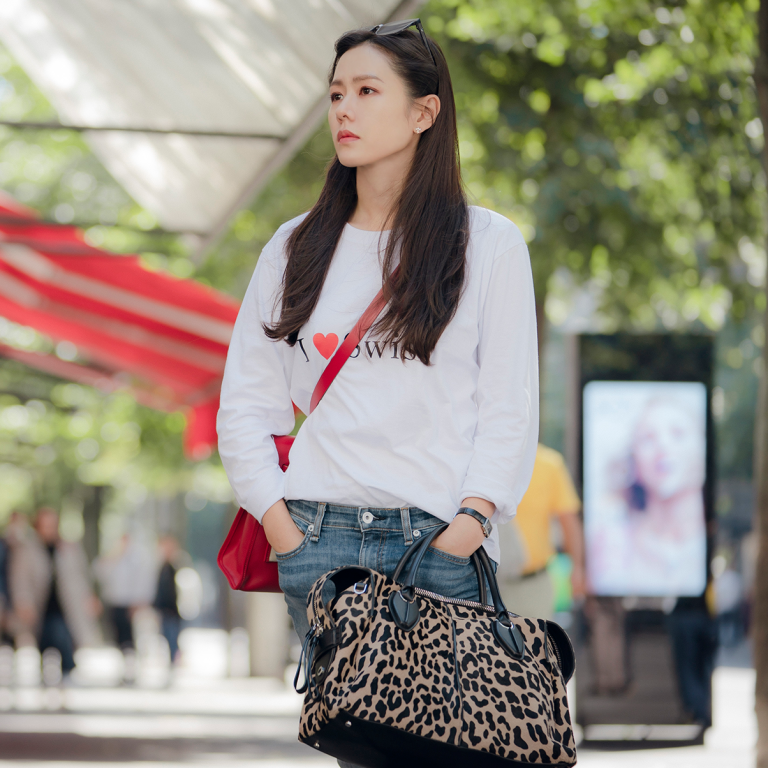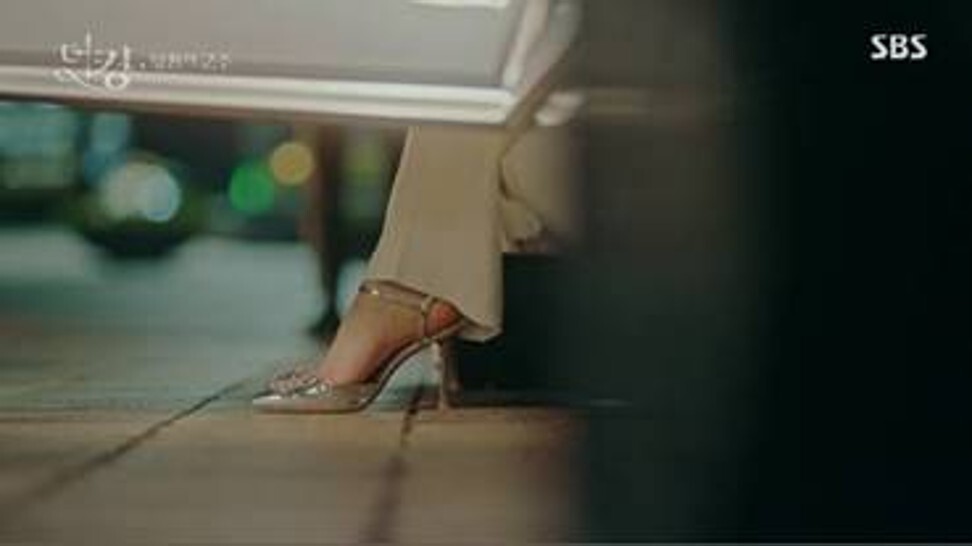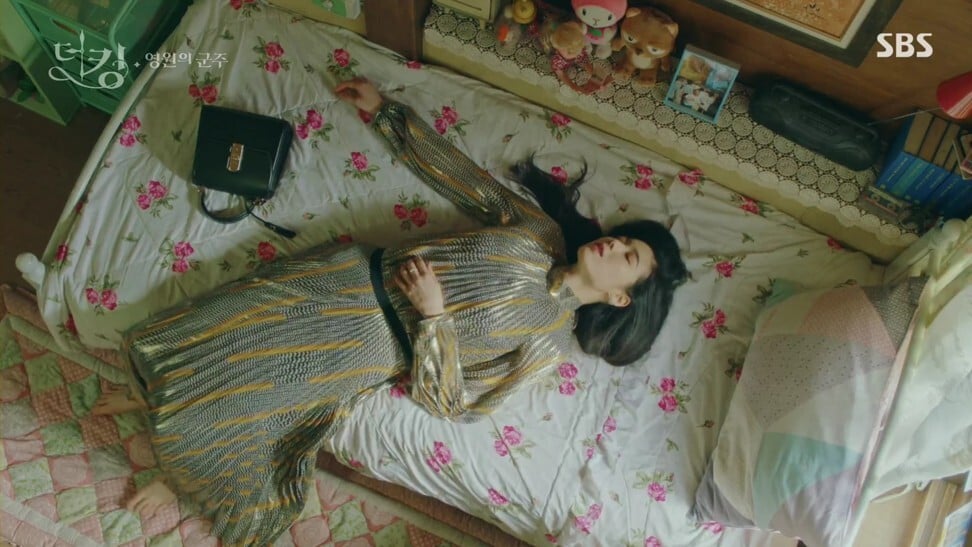
Luxury brands from Miu Miu to Montblanc turn to Korean dramas like The World of the Married to target younger generations
- With so many luxury brand events cancelled this year because of Covid-19, many labels are using product placement in increasingly popular K-dramas
- Such moves have proven to pay off, like when a pair of Jimmy Choos sold out in days after appearing in My Love from the Star
Celebrity red carpet events are largely on hold in the real world because of the pandemic, but an Alexander McQueen pre-spring 2020 ensemble and a pair of Roger Vivier heels are having their moment in fictional worlds.
Meanwhile, Roger Vivier’s bouquet strass slingback pumps make an appearance in two episodes of The King: Eternal Monarch , a K-drama on Netflix, where they are worn by actress Jung Eun-chae.
They aren’t the only labels popping up in Korean dramas – the female lead character of hit show Crash Landing On You can be spotted carrying bags from labels such as Tod’s, Miu Miu and Alaia in many pivotal scenes. Stills of Son Ye-jin’s character wearing these items are handed out by the brands to their followers online and to fashion editors via elaborate press releases.

The marketing strategies of luxury brands around the world have been strained as social distancing measures limit opportunities to add the human touch to what they do. In-person, extravagant, experiential events – including fashion presentations and product launches, as well as behind-the-scenes efforts like shoots and production activities – have largely been cancelled or have pivoted to digital. The current situation in South Korea, though, paints a slightly different picture.
“Korea is one of very few countries in the world where production is back on, although strict safety practices have been put in place,” says Inhae Yeo, director of global communications agency Oikonomos. “So filming is happening as we speak, which is phenomenal, and I think it’s the perfect opportunity for luxury brands to be more creative and engage more actively from the production planning stage.”

The communication strategies of luxe brands in Korea have been moving to digital channels, including streaming platforms – where their Gen Z and millennial audience spends most of its time – and away from print.
In 2019, Netflix set the stage when it gained twice as many new subscribers in South Korea as it did the year before, adding 1.5 million viewers. Then there’s the runaway hit of the past year, Crash Landing on You, which tells the story of a South Korean heiress who finds herself on the other side of the border.

The show’s depiction of North Korean life, and the love story between the heiress and a North Korean soldier, captivated viewers who have made the show the second most popular in the history of cable TV in South Korea.
And of course, like K-pop, Korean dramas are growing in popularity across the West, with streaming platforms exposing new audiences to the country’s television culture. The second season of zombie-filled historical drama Kingdom, Netflix’s first Korean show, dropped just as lockdowns were taking hold across the United States and much of Europe.
Thank Blackpink’s Jennie for this South Korean fashion explosion
Netflix is expanding its K-drama portfolio, signing deals with a number of Korean production companies to create new shows.
“These K-dramas have such a wide reach, with audiences and fans not only in Korea but all over Asia, and even sometimes in Europe, as well,” says Maria Cristina Lomanto, brand general manager of Roger Vivier (Worldwide). “It definitely helps with visibility for [Roger Vivier] but we make sure we study every aspect of each drama carefully to measure potential success and also have celebrities and storylines that are aligned with our maison’s values.”
Product placement (PPL) has been part of Roger Vivier’s strategy since it launched in Korea in 2014. “We have been working closely with top stylists, celebrities and, sometimes, even the TV producers to get information on upcoming shows,” Lomanto says. “Then, we analyse each one to spot opportunities for product placement.”

In China, too, where celebrity idols are among the main growth driver for luxury brands, PPL efforts have famously buoyed luxury brands. But attempts have also been known to go too far.
The blueprint for Return the World to You becomes clear when you consider that the series was sponsored by Shenzhen fashion house Ellassay and produced by Diamond Pictures, a company founded by the chairman and CEO of Chinese jewellery label Leysen Jewellery. Diamond jewellery makes numerous cameos throughout the season, whose fictional plot is set in the workplace of the Ellassay clothing brand.
Big brands place their products in some of the popular webtoons as they would in K-dramas and I’d love to see more luxury fashion and beauty brands in these toons
Yeo says that Korean consumers are particularly attuned to poor attempts at product placement. “They will turn their backs on dramas that don’t have a great storyline, period,” she says.

Product placement can be aesthetically jarring while paying off for the brand in sales and brand recognition. Writing for K-drama review website Dramabeans, author Missvictrix says Subway’s ubiquity in K-dramas reached a “farcical level” in 2016, popping up in many shows.
“No drama was without a convenient date, picnic, or take-out order from this omnipresent sandwich place,” she says.

Park Min-young’s performances as well-dressed white-collar women in Her Private Life and What’s Wrong With Secretary Kim have led to her name frequently appearing in search terms for accessories including earrings, watches and bags. Park’s character in Her Private Life wore jewellery from Rosemont, a brand which she also served as a spokesperson for.
“Big brands place their products in some of the popular webtoons as they would in K-dramas and I’d love to see more luxury fashion and beauty brands in these toons,” she says. “Online streaming has been popular and there is demand and interest for creative content that focuses on the designers and their voices in creating the collections for luxury brands.”

